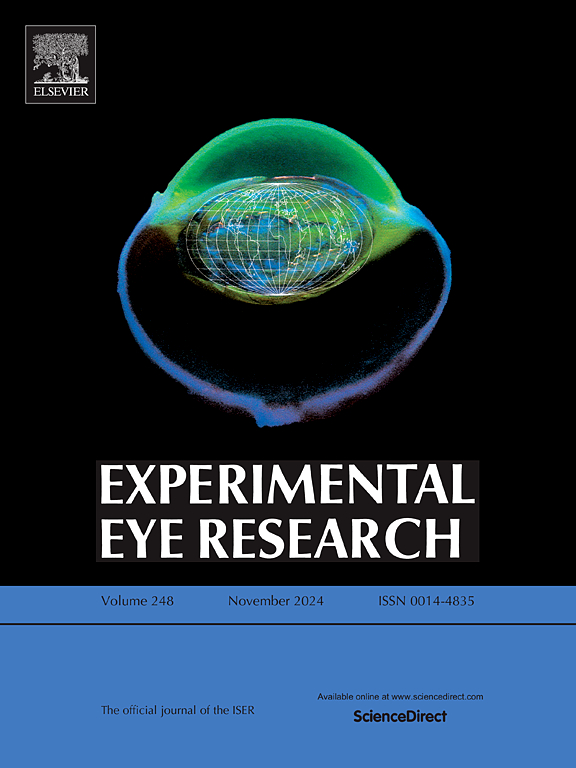Inhibition of matrix metalloproteases by a chemical cross-linker to halt the corneal degradation in keratoconus
IF 3
2区 医学
Q1 OPHTHALMOLOGY
引用次数: 0
Abstract
The need for better and simpler alternative crosslinking strategies to treat keratoconus (KC) is becoming essential as there is only a single approved way to treat it. Recently, conventional UV-A Riboflavin crosslinking is proven to have some disadvantages such as causing damage to the corneal endothelium and inducing keratocyte apoptosis. A chemical cross-linker (CXL) using carbodiimide chemistry and an octanedioic acid spacer is found effective in stiffening the cornea and has the potential to be developed as an alternative therapy to halt KC progression. In order to investigate the molecular changes induced by the cross-linker, we have analyzed the effect of the cross-linker on the activity of matrix metalloproteases (MMPs) in epithelial and stromal layers of KC corneas and in vitro cellular systems to determine its role in stiffening the KC cornea. At well-optimized concentration, KC corneal buttons were treated with the CXL and the stiffening of the cornea was measured. The collagen fibril assembly in the stroma was analyzed using transmission electron microscopy and the activity of MMPs 2 and 9 were visualized using gelatin zymography. KC corneal fibroblasts in culture and tumor necrosis factor-α (TNF-α) induced human corneal epithelial (HCE) cell line were treated with CXL and secretion of MMPs 1, 2, 3 and 9 were analyzed by enzyme-linked immunosorbent assay (ELISA). We found that the CXL stiffened the KC corneas comparable to the normal corneas, with very less cytotoxicity. The collagen fiber assembly was reorganized in an orderly fashion and fibril density and diameter increased after CXL treatment. The activity of MMPs and cathepsin G in the epithelial and stromal layers of KC tissues decreased post-treatment. Secretion and activity of MMPs from the corneal epithelial and stromal cells after CXL treatment were significantly reduced while the epithelial lysyl oxidase activity increased. The CXL, intended to stop the KC progression, modified the extracellular matrix collagen assembly in the stroma and decreased the secretion of a group of metalloproteases and their activity. We have demonstrated a set of molecular changes effected by the CXL, which might aid in the stiffening of the KC cornea.

化学交联剂抑制基质金属蛋白酶以阻止圆锥角膜的角膜退化。
由于目前只有一种经批准的治疗圆锥角膜的方法,因此需要更好、更简单的交联治疗方法。近年来,传统的UV-A核黄素交联方法被证明存在损伤角膜内皮、诱导角膜细胞凋亡等缺点。一种化学交联剂(CXL)使用碳二亚胺化学和辛烷二酸间隔剂被发现可以有效地硬化角膜,并且有潜力作为一种替代疗法来阻止KC的进展。为了研究交联剂诱导的分子变化,我们分析了交联剂对KC角膜上皮和基质层以及体外细胞系统中基质金属蛋白酶(MMPs)活性的影响,以确定其在KC角膜硬化中的作用。在最佳浓度下,用CXL处理KC角膜按钮,并测量角膜的硬化。用透射电镜分析基质中胶原原纤维的组装,用明胶酶谱法观察MMPs 2和9的活性。用CXL处理培养的KC角膜成纤维细胞和肿瘤坏死因子-α (TNF-α)诱导的人角膜上皮(HCE)细胞株,酶联免疫吸附试验(ELISA)检测MMPs 1、2、3和9的分泌情况。我们发现CXL使KC角膜硬化,与正常角膜相比,细胞毒性非常小。CXL处理后,胶原纤维组装有序重组,纤维密度和直径增加。KC组织上皮和间质层的MMPs和组织蛋白酶G活性降低。CXL处理后,角膜上皮细胞和基质细胞中MMPs的分泌和活性显著降低,而上皮赖氨酸氧化酶活性升高。为了阻止KC的进展,CXL改变了基质中的细胞外基质胶原蛋白组装,降低了一组金属蛋白酶的分泌及其活性。我们已经证明了一组受CXL影响的分子变化,这可能有助于KC角膜的硬化。
本文章由计算机程序翻译,如有差异,请以英文原文为准。
求助全文
约1分钟内获得全文
求助全文
来源期刊

Experimental eye research
医学-眼科学
CiteScore
6.80
自引率
5.90%
发文量
323
审稿时长
66 days
期刊介绍:
The primary goal of Experimental Eye Research is to publish original research papers on all aspects of experimental biology of the eye and ocular tissues that seek to define the mechanisms of normal function and/or disease. Studies of ocular tissues that encompass the disciplines of cell biology, developmental biology, genetics, molecular biology, physiology, biochemistry, biophysics, immunology or microbiology are most welcomed. Manuscripts that are purely clinical or in a surgical area of ophthalmology are not appropriate for submission to Experimental Eye Research and if received will be returned without review.
 求助内容:
求助内容: 应助结果提醒方式:
应助结果提醒方式:


